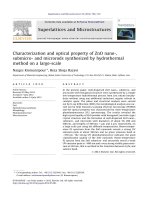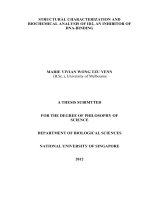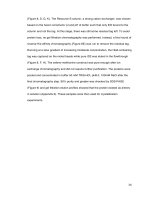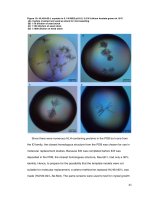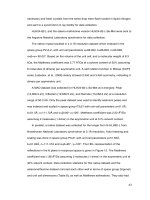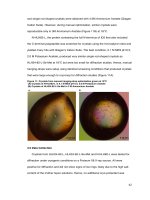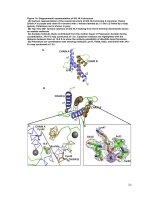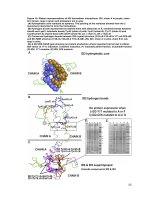Characterization and genetic potential of ginger genotypes evaluated in Terai Region of West Bengal, India
Bạn đang xem bản rút gọn của tài liệu. Xem và tải ngay bản đầy đủ của tài liệu tại đây (289.3 KB, 11 trang )
Int.J.Curr.Microbiol.App.Sci (2019) 8(4): 1147-1157
International Journal of Current Microbiology and Applied Sciences
ISSN: 2319-7706 Volume 8 Number 04 (2019)
Journal homepage:
Original Research Article
/>
Characterization and Genetic Potential of Ginger Genotypes Evaluated in
Terai Region of West Bengal, India
D. Basak1, S. Chakraborty1*, A. Sarkar1, M.K. Debnath2, A. Kundu1 and S. Khalko3
1
Department of Genetics and Plant Breeding, 2Department of Agricultural Statistics,
3
Department of Plant Pathology, UBKV, Pundibari, Coochbehar-736165
*Corresponding author
ABSTRACT
Keywords
Path analysis,
Rhizome thickness,
Leven's test, Cluster
analysis, Gap
statistic, Correlation
coefficient
Article Info
Accepted:
10 March 2019
Available Online:
10 April 2019
Character association and path analysis studies were investigated in 2016-2017 and 20172018 in all physical and rhizome characters of ginger to find out the influence of characters
among themselves on yield. Characters were investigated according to the DUS
descriptors as described by Indian Institute of Spices Research, Kozhikode, Kerala.
Number of leaves had the highest positive direct effect (1.759) on yield followed by
number of shoots (1.053) and rhizome thickness (0.460). The correlation coefficients
among the different characters at phenotypic and genotypic levels revealed that Rhizome
thickness (0.45*) was the only trait having positive and significant correlation with
rhizome yield (t/ha). Number of leaves had the highest positive direct effect on yield
followed by number of shoots and rhizome thickness indicating that selection should be
made on the basis of these characters taking other characters into consideration, while
making improvement in yield of ginger. In cluster analysis, gap statistics was done to find
optimal number of clusters and two groups of clusters were found. So, genotypes GCP-39,
SEHP-9, SE-8640, SG-2640, SE-8681 and ACC-247 should be chosen for cultivation
among these genotypes in this region of West Bengal.
Introduction
Ginger was originated in the tropical
rainforest in South-East Asia although ginger
no longer grows wild, and it is thought to
have originated on the Indian sub-continent
because the ginger plants grown in India show
the largest amount of genetic variation.
Ginger was exported to Europe via India in
the first century AD and was used extensively
by the Romans. India has been known from
prehistoric times as the land of spices. Until
the 1970s, India had a virtual dominance in
the international spices trade. India still
continues to be the largest producer,
consumer, and exporter of spices flavour
foods in over 130 countries and their intrinsic
values make them distinctly superior in terms
of taste, colour and fragrance. The USA,
Canada, Germany, Japan, Saudi Arabia,
Kuwait, Bahrain and Israel are the main
markets for Indian spices. The main ginger
1147
Int.J.Curr.Microbiol.App.Sci (2019) 8(4): 1147-1157
growing countries are India, China, Jamaica,
Taiwan, Sierra Leone, Nigeria, Fiji,
Mauritius,
Indonesia,
Bangladesh,
Philippines, Sri Lanka, Thailand, Trinidad,
Uganda, Hawaii, Guatemala, and many
Pacific Ocean Islands(Peter, 2007).
Ginger has many fibrous roots, aerial shoots
(pseudo shoots) with leaves and the
underground stems (rhizome) (Ravindran and
Babu, 2005). The economic part of ginger is
rhizome, modified underground stem, often
sending out roots and shoots from its nodes.
Plant height can reach 90 cm when it is fully
grown (Rashid et al., 2013), the leafy shoot is
the pseudo-stem constituted of leaf sheath and
bears 8-12 leaves (Vasala, 2001). The leaves
are lanceolate to linear-lanceolate with 15-30
cm in length (Malhotra and Singh, 2003) and
2-3 cm width with sheathing bases (Mishra et
al., 2012) which die off each year.
variation were calculated by using the
formulae given by Burton and De-Vane
(1953).The estimates of PCV and GCV were
classified as low (<15%), moderate (15-30%)
and high (>30%). Heritability in broad sense
(h2b) was estimated according to Allard
(1960).The estimates were classified as low
(<50%), moderate (50-80%) and high (>80%)
suggested by Robinson, 1996).The present
investigation on genetic divergence was
worked out on 18 genotypes based on 8
characters. The more diverse the parents,
within overall limits of fitness, the greater the
chances of obtaining higher amount of
heterotic expression in F1 and broad spectrum
of variability in segregating generations. The
objective of this work is to group a set of 18
genotypes into different clusters according to
the genetic divergence. The statistical analysis
was carried out by using statistical software R
3.5.3 ( />
Materials and Methods
Results and Discussion
The estimates of variability viz. coefficient of
variability (phenotypic and genotypic),
heritability (in broad sense), genetic advance
and genetic gain (as percent of mean) were
worked for selection of various characters.18
genotypes of ginger were taken for
characterization, evaluation in this region in
order to find out the suitability of growing in
this region. The list of genotypes was given in
Table 1.
Coefficients of variability
The list of characterization of different
morphological studies including vegetative
characters and rhizome characters were given
in Table 2 which were done by Indian
Institute of Spices Research. Each piece was
2.5 to 5 cm long and 22 to 25 gm. in weight.
The genotypes were sown in a randomized
complete block design (RCBD) with 3
replications during two consecutive seasons
of 2016 - 2017 and 2017- 2018.The
phenotypic and genotypic coefficients of
High GCV value was observed for yield (t/ha)
(43.26%) and number of shoots (32.4%)
(Table 3). Moderate GCV value was observed
for height of shoot (19.46%), number of
leaves (15.96%) and rhizome thickness
(15.05%). Lowest GCV value was observed
for leaf width (7.45%) followed by leaf length
(11.22%) and plant height (13.69%) (Table
3). High PCV value was observed yield (t/ha)
(45.2%). Moderate PCV value was recorded
for plant height (15.8%), height of shoot
(25.66%), number of leaves (23.04%), leaf
length(15.89%)
and
rhizome
thickness(15.49%). Lowest PCV value was
observed for number of shoots (13.36%) and
leaf width (13.36%) (Table 3).
Similar results were reported for high GCV in
rhizome yield by Aragaw et al., (2011);
Rajyalakshmi and Umajyothi (2014); Yadav
1148
Int.J.Curr.Microbiol.App.Sci (2019) 8(4): 1147-1157
(1999) and Sasikumar et al., (1992). High
GCVfor number of shoots was also reported
by Rajyalakshmi and Umajyothi, (2014); Das
et al., (2000); Jatoi and Watanabe (2013) and
Mohanty et al., (1981). Similar result for
moderate GCV value for number of leaves
was observed by Sasikumar et al., (1992) and
moderate GCV for rhizome thickness
observed by Jatoi and Watanabe (2013). High
PCV values were reported by Singh et al.,
(2002); Rajyalakshmi and Umajyothi (2014)
and Aragaw et al., (2011) for rhizome yield.
Moderate PCV was reported for plant height
by Sasikumar et al., (1992); for number of
leaves Sasikumar et al., (1992); for leaf length
and rhizome thickness by Sasikumar et al.,
(1992). Low PCV values were reported by
Korla and Tiwari (1999) and Tiwari (2003)
for number of shoots and leaf width. Higher
magnitude of PCV and GCV was observed
for yield per plot. GCV and PCV were
moderate for shoot length, number of leaves
and rhizome thickness. This indicates wide
range of variation among these traits. Lowest
values of GCV and PCV for leaf length and
leaf width suggested rather limited variability
and need to generate more variability for
wider spectrum of selection.
Heritability
Heritability was found high for rhizome
thickness (94.26%) and yield (t/ha) (91.36%)
(Table 3). Moderate heritability was estimated
for plant height (75.06%), number of shoots
(67.97%) and height of shoot (57.51%).
Heritability was found low for leaf length
(49.87%), number of leaves (47.98%) and leaf
width (30.67%) (Table 3). Similar results for
moderate to high heritability for rhizome
yield, plant height, height of shoot and
number of shoots were reported by Aragaw et
al., (2011); Rajyalakshmi and Umajyothi
(2014); Singh et al., (2002); Parmar (2011);
Islam et al., (2008) and Korla and Tiwari
(1999).
Genetic advance and genetic gain
High genetic gain was observed for rhizome
yield (t/ha) (85.07%) and number of shoots
(55.04%) (Table 3). Moderate genetic gain
was observed for rhizome thickness (30.8%)
and shoot length (30.4%). Low genetic gain
was observed for plant height (24.43%),
number of leaves (22.77%) and leaf length
(16.33%). Genetic gain was very low for leaf
width (8.5%) (Table 3). Similar results for
high genetic advance and genetic gain were
observed for rhizome yield by Aragaw et al.,
(2011); Rajyalakshmi and Umajyothi (2014);
Singh et al., (2002); Parmar (2011); Islam et
al., (2008). High heritability coupled with
high genetic gain was estimated for yield per
plot/ hectare, indicating that it is under
additive gene effects and selection would be
very effective. High heritability coupled with
moderate genetic gain for rhizome thickness,
plant height and number of shoots was also
observed suggesting that selection would be
more effective for these traits.
Correlation studies
Correlation coefficients among the different
characters were worked out at phenotypic and
genotypic levels from the pooled data.
Phenotypic correlation
The phenotypic correlation coefficients
among different characters revealed that only
rhizome thickness (0.46**) had significant
positive association with yield (t/ha) (Table
4). While significant and negative correlation
of yield (t/ha) with number of shoot (-0.50*)
was observed. Plant height showed significant
and positive correlation with shoot height
(0.96**), number of leaves (0.82**), leaf
length (0.66**), and number of shoots
(0.80**) (Table 4). Height of shoot showed
significant and positive correlation with plant
height (0.96**), number of leaves (0.90**),
1149
Int.J.Curr.Microbiol.App.Sci (2019) 8(4): 1147-1157
leaf length (0.70**), and number of shoots
(0.77**).Number of leaves showed significant
and positive correlation with plant height
(0.82**), height of shoot (0.90**), leaf length
(0.71**), and number of shoots (0.67**).Leaf
length showed significant and positive
correlation with plant height (0.66**), height
of shoot (0.70**), number of leaves (0.71**),
number of shoots (0.81**) and leaf width
(0.63**). Number of shoots showed
significant and positive correlation with plant
height (0.80**), height of shoot (0.77**),
number of leaves (0.67**), leaf length
(0.81**) and leaf width (0.65**). Leaf width
showed significant and positive correlation
with leaf length (0.63**) and number of
shoots (0.65**) (Table 4). Similar result for
rhizome thickness was reported by Abraham
and Latha (2003), Nandkangre et al., (2016)
and Jatoi and Watanabe (2013).
Genotypic correlation
The genotypic correlation coefficients among
different characters revealed that only
rhizome thickness (0.48**) had significant
positive association with yield (t/ha).All other
characters had significant negative association
with yield. Yield (t/ha) was found significant
and negative correlation with plant height (0.30*), height of shoot (-0.47**), number of
leaves (-0.46**), leaf length (-0.46**),
number of shoots (-0.54**) and leaf width (0.26*) (Table 4). Rhizome thickness showed
significant and negative correlation with shoot
length (-0.38**), number of leaves (-0.39**),
leaf length (-0.47**), number of shoots (0.35**) and leaf width (-0.61**). Plant height
had significant and positive correlation with
shoot length (0.99**), number of leaves
(0.98**), leaf length (0.76**), number of
shoots (0.87**) and leaf width (0.49**)
(Table 4). Leaf length showed significant and
positive correlation with number of shoots
(0.90**) and leaf width (0.80). Number of
leaves showed significant and positive
correlation with shoot length (0.96**) (Table
4).
The correlation coefficients among the
different characters were worked out at
phenotypic and genotypic levels. In general,
the genotypic correlation coefficients were
higher in magnitude than phenotypic
correlation coefficients which was also
reported by Medhi et al., (2007), indicating a
strong inherent association among the traits.
The phenotypic and genotypic correlation
coefficients among different characters
showed that rhizome yield had significantly
positive association with rhizome thickness
while significantly negative correlation was
observed with number of shoots. Rhizome
thickness is the only character we may choose
for prediction of high yield. Similar result for
rhizome thickness was reported by Abraham
and Latha (2003), Nandkangre et al., (2016)
and Jatoi and Watanabe (2013). Govind and
Chandra (1999); Rajyalakshmi and Umajyothi
(2014) and Lincy et al., (2008) earlier
reported significant negative correlation
between number shoots and rhizome yield.
Path coefficient analysis
Path coefficient analysis from the pooled data
of two years depicts the effects of different
independent characters individually and in
combination with other characters on the
dependent
character
rhizome
yield.
Considering rhizome yield as effect and seven
characters as causes, genotypic correlation
coefficients were partitioned by using the
method of path analysis, to find out the direct
and indirect effects of yield contributing
characters towards rhizome yield (Table 5).
Genotypic path
The data regarding genotypic path revealed
that Number of leaves had the highest positive
direct effect (1.759) on yield followed by
1150
Int.J.Curr.Microbiol.App.Sci (2019) 8(4): 1147-1157
number of shoots (1.053) and rhizome
thickness (0.460) (Table 5). Number of shoots
showed high positive direct effect (1.053) on
yield and high positive indirect effect through
number of leaves (1.214) (Table 5). Plant
height had the highest negative direct effect (1.243) and very high positive indirect effect
through number of leaves (1.724) and number
of shoots (0.916) (Table 5). Shoot length had
high negative direct effect (-1.10) and very
high positive indirect effect through number
of leaves (1.689) and number of shoots
(0.864) (Table 5). Number of shoots showed
high positive indirect effect through number
of leaves (1.214). Leaf length showed high
positive indirect effect through number of
leaves (1.214) and number of shoots (0.948)
(Table 5). Leaf width also showed high
positive indirect effect through number of
leaves (1.038) and number of shoots (0.864)
(Table 5). The residual effect for genotypic
path was 0.993 (Table 5). Number of leaves
had the highest positive direct effect on yield
followed by number of shoots and rhizome
thickness indicating that selection should be
made on the basis of these characters taking
other characters into consideration, while
making improvement in yield of ginger. High
positive direct effect of number of leaves,
number of shoots and rhizome thickness on
rhizome yield was earlier reported by Ravi et
al.,(2017); Jatoi et al., (2013); Islam et al.,
(2008) and Abrahm and Latha (2003).
Distribution of different ginger genotypes
into various clusters
Cluster analysis
A hierarchical clustering analysis was carried
out on different phenotypic traits viz. Plant
height (cm), Shoot length (cm), Number of
leaves, Leaf length (cm), Number of shoots,
Leaf width(cm), Rhizome thickness (cm) and
Yield (t/ha) resulted in two clusters (Fig. 1a
and Table 6).
Table.1 List of ginger genotypes and their origin
Sl.
No.
1
Name of Genotype
Place of origin
GCP-51
2
GCP-56
3
4
GCP-5 (Garubathan)
Local check
GCP-46
5
GCP-30
6
GCP-36
7
GCP-39
8
GCP-14
9
SEHP-9
Dinhata, Cooch Behar,West
Bengal
Totopara, Alipurduar, West
Bengal
Garubathan, Darjeeling, West
Bengal
Mangalabari, Jaigaon, West
Bengal
Majhian, South Dinajpur, West
Bengal
Uttar Madarihat, Alipurduar,
West Bengal
Totopara, Alipurduar, West
Bengal
Jambari, Cooch Behar, West
Bengal
Telengana
1151
Sl.
No.
10
Name of
Genotype
ACC-578
Place of origin
11
SE-8631
Telengana
12
ACC-219
IISR, Kerala
13
SE-8640
14
SG-26-40
TNAU, Tamil
Nadu
Kerala
15
SE-8681
Telengana
16
ACC-247
IISR, Kerala
17
VARADA
National check
KARTHIKA
IISR Variety,
Kerala
Kerela Agricultural
University
18
IISR, Kerala
Int.J.Curr.Microbiol.App.Sci (2019) 8(4): 1147-1157
Table.2 Different morphological and rhizome characteristics according to PPV & FRA act
S No.
Characteristics
States
1
Plant: Height (cm)
2
Short (<100), Medium
(100 - 120), Tall (>120)
Few (<10), Medium (10 15) Many(>15)
Short (<75), Medium (75 90) Tall (> 90)
Few (<25) Medium (2535) Many (>35)
Plant: Number of
shoots
Plant: Height of
shoot (cm)
Shoot: Number of
leaves on main
shoot
Leaf: Length (cm)
Short (<25), Medium (25 30), Long (>30)
Leaf: Width (cm)
Narrow (<2.5), Medium
(2.5 - 3.5), Broad (>3.5)
Rhizome: Thickness Thin (<2), Medium (2-3),
(cm)
Bold (>3)
Rhizome: Shape
Straight,
Curved,
Zigzagged
3
4
5
6
7
8
Stage of observation
Type of
Assessment
At the end of the MS
growing phase
At the end of the MS
growing phase
At the end of the MS
growing phase
Full expansion of MS
leaves achieved
Full expansion of MS
leaves achieved
Full expansion of MS
leaves achieved
At the time of harvest
MS
At the time of harvest
VG
Table.3 Phenotypic and genotypic coefficient of variation, heritability, genetic advance and
genetic gain for nine characters in ginger. (Pooled Data Analysis)
Characters
Grand
Mean
Range
Max
Min
GCV
(%)
PCV
(%)
Plant height
(cm)
Height of shoot
(cm)
Number of
leaves
Leaf length
(cm)
Number of
shoots
Leaf width
(cm)
Rhizome
thickness (cm)
Yield(tonne/ha)
59.59
70.63
13.69
15.8
42.46
53.72
33.18
19.46
25.66
57.51
12.91
30.4
14.31
16.67
10.67
15.96
23.04
47.98
3.26
22.77
21.25
23.79
17.64
11.22
15.89
49.87
3.45
16.33
6.1
8.33
3.33
32.4
13.36
67.97
3.35
55.04
2.21
2.61
1.99
7.45
13.45
30.67
0.19
8.5
2.24
2.95
1.88
15.05
15.49
94.26
0.67
30.08
5.37
8.89
3.13
43.26
45.2
91.36
4.57
85.07
50.72
1152
Heritability Genetic
(%)
advance
(%)
14.56
75.06
Genetic
gain
(%)
24.43
Int.J.Curr.Microbiol.App.Sci (2019) 8(4): 1147-1157
Table.4 Genotypic and phenotypic correlation
Plant height
(cm)
Shoot length
(cm)
Number of
leaves
Leaf length
(cm)
Number of
shoots
Leaf width
(cm)
P
G
P
G
P
G
P
G
P
G
P
G
P
G
Shootlength
(cm)
Number
of leaves
0.96**
0.99**
0.82**
0.98**
0.90**
0.96**
Leaf
length
(cm)
0.66**
0.76**
0.70**
0.70**
0.71**
0.69**
Number
of shoots
0.80**
0.87**
0.77**
0.82**
0.67**
0.69**
0.81**
0.90**
Leaf
width
(cm)
0.39
0.49**
0.4
0.52**
0.45
0.59**
0.63**
0.80**
0.65**
0.82**
Rhizome
thickness
(cm)
-0.17
-0.19
-0.34
-0.38*
-0.32
-0.39*
-0.41
-0.47**
-0.31
-0.35*
-0.53**
-0.61**
Yield
(t/ha).
-0.28
-0.30*
-0.42
-0.47**
-0.39
-0.46*
-0.39
-0.46**
-0.50**
-0.54**
-0.23
-0.26*
0.46**
0.48**
Rhizome
thickness
(cm)
**. Correlation is significant at the 0.01 level. *. Correlation is significant at the 0.05 level.
Table.5 Direct (Diagonal) and indirect effect of genotypic path coefficients (Pooled)
Plant height (cm)
Plant
height
(cm)
-1.243
Shoot
length
(cm)
-1.133
Number
of
leaves
1.724
Leaf
length
(cm)
-0.276
Number
of
shoots
0.916
Leaf
width
(cm)
-0.2
Rhizome
thickness
(cm)
-0.087
Shoot length (cm)
-1.28
-1.1
1.689
-0.255
0.864
-0.213
-0.175
Number of leaves
-1.218
-1.056
1.759
-0.251
0.727
-0.241
-0.179
Leaf length (cm)
-0.945
-0.77
1.214
-0.364
0.948
-0.327
-0.216
Number of shoots
-1.081
-0.902
1.214
-0.327
1.053
-0.335
-0.161
Leaf width (cm)
-0.609
-0.572
1.038
-0.291
0.864
-0.409
-0.281
Yield
(t/ha).
-0.300*
0.470**
-0.460*
0.460**
0.540**
-0.260*
0.236
0.418
-0.686
0.171
-0.369
0.249
0.480**
Rhizome
0.46
thickness (cm)
Residual effect=0.99352
**. Correlation is significant at the 0.01 level. *. Correlation is significant at the 0.05 level.
1153
Int.J.Curr.Microbiol.App.Sci (2019) 8(4): 1147-1157
Table.6 Mean, Range and Variance for various traits of ginger under different clusters evaluated
inTerai region of West Bengal
Cluster-1 (09)
[GCP-51,GCP-56,GCP5,GCP-46,GCP-30,GCP36,GCP-39,ACC-219,
KARTHIKA]
Cluster-2 (09)
[GCP-14,SEHP-9,ACC578,SE-86-31,SE8640,SG-26-40,SE8681,ACC247,VARADA]
Entire Genotype (18)
F Value
P value
PH
Mean
64.54
Min.
59.82
Max.
70.63
Variance 9.25
Mean
54.63
Min.
50.72
Max.
61.31
Variance 14.01
SL
48.22
45.61
53.72
6.86
36.71
33.18
43.00
9.11
NL
15.86
14.83
16.67
0.47
12.76
10.67
15.00
1.62
LL
22.32
20.08
23.79
2.00
19.98
17.64
22.29
2.91
RT
2.13
1.98
2.32
0.01
2.35
1.88
2.95
0.09
YLD
4.50
3.13
6.41
0.76
6.23
3.59
8.89
3.45
Mean
Min.
Max.
Variance
42.46
33.18
53.72
42.57
0.069
NS
14.31
10.67
16.67
3.52
2.018
NS
21.15 6.10 2.21 2.24
17.64 3.33 1.99 1.88
23.79 8.33 2.61 2.95
3.76 2.26 0.02 0.06
0.685 0.179 0.561 4.122
NS
NS
NS
**
5.37
3.13
8.89
2.77
7.323
**
59.59
50.72
70.63
36.94
0.215
NS
NS
7.26
5.67
8.33
0.93
4.94
3.33
6.17
0.86
LW
2.29
2.11
2.61
0.03
2.13
1.99
2.26
0.01
** variances were tested using Leven's test
PH=Plant height (cm), SL=Shoot length (cm), NL=Number of leaves, LL=Leaf length(cm), NS=Number of shoots,
LW=Leaf width(cm), RT=Rhizome thickness (cm) YLD=Yield (t/ha)
Fig.1 No of cluster (a) and cluster dendrogram (b) for different genotypes of ginger evaluated in
Terai region of West Bengal
1154
Int.J.Curr.Microbiol.App.Sci (2019) 8(4): 1147-1157
Fig.2 cluster biplot for different genotypes of ginger evaluated in Terai region of West Bengal
Cluster 1 consisted of 9 genotypes (GCP-51,
GCP-56, GCP-5, GCP-46, GCP-30, GCP-36,
GCP-39, ACC-219, KARTHIKA). Cluster 2
also consisted of 9 genotypes (GCP-14,
SEHP-9, ACC-578, SE-86-31, SE-8640, SG26-40, SE-8681, ACC-247, VARADA).
Cluster biplot (Fig. 2) also indicate the similar
grouping of genotypes. Mean, Range and
Variance for various traits of ginger under
different clusters evaluated in Terai region of
West Bengal are presented in Table 6.
The gap statistic (Tibshirani et.al. 2001)
approach was applied for hierarchical
clustering to identify the optimum number of
clusters (Fig. 1a). The gap statistic compares
the total intracluster variation for different
values of k with their expected values under
null reference distribution of the data (i.e. a
distribution with no obvious clustering).
The homogeneity of variances for different
clusters was tested by Levene’s test (Levene,
1960). The variances were heterogeneous
(p=0.05) for Rhizome thickness and yield but
variance were found homogeneous for other
traits. Variance was more in cluster 2 for
Rhizome thickness and yield.
In conclusion, the correlation coefficients
among the different characters at phenotypic
and genotypic levels revealed that Rhizome
thickness (0.45*) was the only trait having
positive and significant correlation with
rhizome yield (t/ha). Rhizome thickness is the
only character we may choose for prediction
of high yield. The data regarding genotypic
path revealed that Number of leaves had the
highest positive direct effect (1.759) on yield
followed by number of shoots (1.053) and
rhizome thickness (0.460). Clustering analysis
and gap statistics was done to identify the
optimum number of clusters and was found to
have two groups according to closeness of
maximum and minimum values and their
respective variances among 18 genotypes.
These characters could thus be utilized by
breeders as selection criteria to develop
1155
Int.J.Curr.Microbiol.App.Sci (2019) 8(4): 1147-1157
higher yielding lines. From the present
investigations it is concluded that for rhizome
yield, genotypes SG-2640, SE-8681 and
ACC-247 excelled the national check
VARADA. Genotypes GCP-39, SEHP-9, SE8640, SG-2640, SE-8681 and ACC-247
excelled the local check GCP-5 for rhizome
yield. These genotypes performed better for
majority of the characters as well. Hence
these genotypes can be recommended for
cultivation in this particular region.
References
Abrahm, Z. and Latha, M. 2003. Correlation
and path analysis in ginger (Zingiber
officinale Rosc.). Journal of Spices
and Aromatic Crops, 12 (2): 187-189.
Aragaw, M., Alamerew, S., Girma, M. H. and
Tesfaye, A. 2011. Variability of
ginger (Zingiber officinale Rosc.)
accessions for morphological and
some quality traits in Ethiopia.
International Journal of Agricultural
Research, 6 (6): 444-457.
Burton, G.W. and E.h. Devane, 1953.
Estimating heritability in tall fescue
(Festuca arundinacea) from replicated
clonal material. Agron. J., 45:48-488.
Das, P., Rai, S. and Das, A. B. 1999. Genetic
advance, heritability and path analysis
in ginger (Zingiber officinale Rosc.).
Journal of Plantation Crops, 27 (1):
27-30.
Islam, K.M., Islam, A. K., Rasul, M. G,
Sultana, N. and Mian, M. A.K. 2008.
Genetic variability and character
association in ginger (Zingiber
officinale Rosc.). Ann. Bangladesh
Agric., 12(1): 33- 39.
Jatoi, A. S. and Watanbe, N. K. 2013.
Diversity analysis and relationships
among ginger landraces. Pakistan
Journal of Botany, 45(4): 1203-1214.
Jatoi, S. A., Kikuchi, A., Mimura, M. Y. S.
and Watanabe, N. 2008. Relationship
of Zingiber species and genetic
variability assessment in ginger (Z.
officinale) accessions from ex-situ
gene bank, on-farm and rural markets.
Breed. Sci., 58: 261-270.
Levene H. 1960. Robust tests for equality of
variances.
In:
Olkin
I (ed.)
Contributions to Probability and
Statistics: Essays in honour of Harold
Hotelling. Stanford University Press,
Stanford, pp 278-292
Malhotra, S. and Singh, AP, 2003. Medicinal
properties of ginger (Zingiber
officinale Rosc.). Natiural Product
reliance, 2(6): 296-301.
Mishra, R.K., Kumar, A. and Kumar, A.
2012. Pharmacological Activity of
Zingiber officinale. International J.
Pharm. Chem. Biol. Sci, 1 (3): 14221427.
Mohanty, D. C., Das, R.C. and Sarma, Y.N.
1981. Variability of agronomic
characters in ginger (Zingiber
officinale Rosc.). Orissa Journal of
Horticulture, 9(1): 15-17.
Nandkangre, H., Ouedraogo, M. and
Sawadogo, M. 2015. Caractérisation
du
système
de
production
dugingembre (Zingiber officinale
Rosc.) au Burkina Faso: Potentialités,
contrainteset perspectives. Int. J. Biol.
Chim. Sci, 9 (2): 861- 873.
Parmar, R. 2011. Molecular characterization
of
Zingiber
officinale
Rosc.
germplasm in H.P. using RAPD as
molecular markers. M.Sc. thesis.
Dr.YSP UHF, Nauni, Solan, HP.
Peter, K. V. 2007. Spices. Horticultural
Science
Series-5,
New
India
Publishing Agencies, New Delhi. 6768.
Rajyalakshmi, R. and Umajyothi, K. 2014.
Evaluation of ginger (Zingiber
officinale Rosc.) varieties in high
altitude and tribal zone of Srikakulam
district of Andhra Pradesh. Journal of
1156
Int.J.Curr.Microbiol.App.Sci (2019) 8(4): 1147-1157
Spices and Aromatic Crops, 23 (2):
258-261.
Rashid, K., Daran, A.B.M., Nezhadahmadi,
A., Zainoldin, K.H.B., Azhar, S. and
Efzueni, S. 2013. The effect of using
gamma rays on morphological
characteristics of ginger (Zingiber
officinale Rosc.) plants. Life Sci. J.,10
(1): 1538-1544.
Ravi, Y., V.B. Narayanpur, J.S. Hiremath,
S.S. Saraswati and Eragegowda, M.
2017. Correlation and Path Coefficient
Analysis
in
Ginger
(Zingiber
officinale Rose.). Int. J. Curr.
Microbiol. App. Sci, 6(4): 1224-1230.
Ravindran, P.N., Nirmal Babu, K., Peter,
K.V., Abraham, Z. and Tyagi, R.K.
2005 Spices. In: B.S. Dhillon, R.K.
Tyagi, S. Saxena and G.J. Randhawa
(eds) Plant Genetic Resources:
Horticultural
Crops,
Narosa
Publishing House, New Delhi. 190 –
227.
Sasikumar, B., Nirmal Babu, K. Abraham, J.
and Ravindran, P. N. 1992.
Variability, correlation and path
analysis in ginger germplasm. The
Indian Journal of Genetics and Plant
Breeding, 52(4): 428-431.
Singh, Y., Katoch, V. and Mittal, P. 2002.
Variability studies in ginger (Zingiber
officinale Rosc.) under humid subtemperate conditions of Himachal
Pradesh. Proceedings of the 15th
plantation
crops
symposium
(placrosym xv), Mysore. India. 173175.
Tibshirani, R., G. Walther, and T. Hastie.
2001. Estimating the number of
clusters in a data set via gap statistic.
J. R. Statist. Soc. B. 63 (2):411-423
Vasala, P.A. 2001. Ginger. In K.V. PETER.
eds. Handbook of herbs and spices.
CRC Press. Abington, Cambridge,
England. 195-205.
Yadav, R. K. 1999. Genetic variability in
ginger (Zingiber officinale Rosc.).
Journal of Spices and Aromatic
Crops, 8(1): 81-83.
How to cite this article:
Basak, D., S. Chakraborty, A. Sarkar, M.K. Debnath, A. Kundu and Khalko, S. 2019.
Characterization and Genetic Potential of Ginger Genotypes Evaluated in Terai Region of West
Bengal, India. Int.J.Curr.Microbiol.App.Sci. 8(04): 1147-1157.
doi: />
1157
